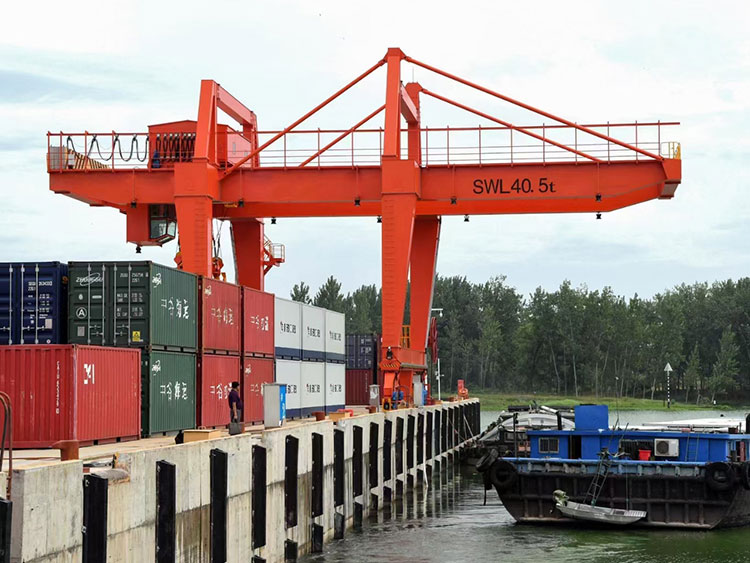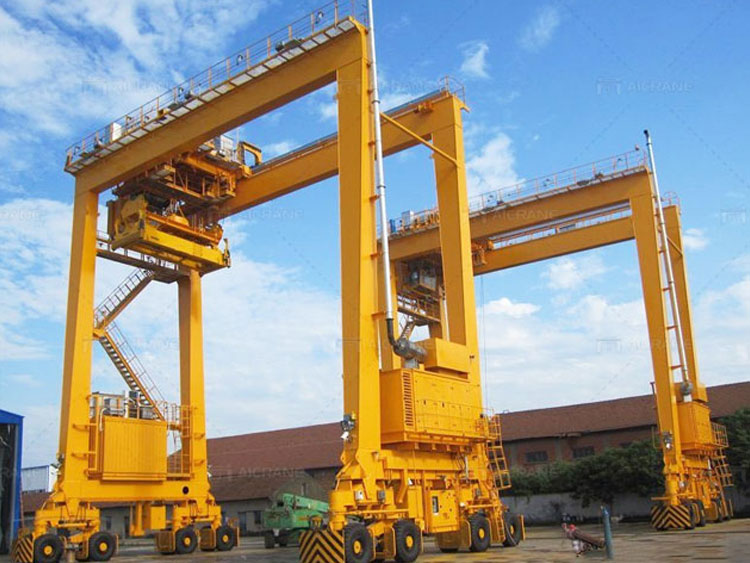Rail Mounted Gantry (RMG) cranes and Rubber Tyred Gantry (RTG) cranes are indispensable to the efficient operations of modern container terminals. These heavy-duty cranes are responsible for stacking and transferring containers, enabling ports to manage a high throughput. However, like all industrial machinery, RMG and RTG cranes require regular maintenance to ensure their smooth operation, reduce downtime, and extend their lifespan.
Proper maintenance not only enhances the performance and safety of these container gantry cranes but also ensures compliance with regulatory requirements. In this article, we will explore the best practices for maintaining RMG and RTG cranes, emphasizing key areas such as preventive maintenance, component checks, lubrication, and operator training.

1. Develop a Preventive Maintenance Schedule
The foundation of effective crane maintenance is the development of a comprehensive preventive maintenance schedule (PMS). This schedule outlines regular maintenance tasks based on time intervals or crane operating hours and includes inspections, servicing, and replacements of parts that experience wear over time. A well-defined PMS helps identify potential issues before they lead to costly breakdowns.
Key components to include in the preventive maintenance plan for RMG and RTG cranes are:
- Inspection of Load Handling Components: Regularly inspect hoists, hooks, ropes, and spreaders for signs of wear or damage.
- Electrical and Control Systems Checks: Routine checks on electrical connections, motors, and control panels ensure that the crane operates efficiently without interruptions.
- Hydraulic Systems Maintenance: For rubber tyred gantry crane that uses hydraulic systems, regular inspections of hoses, filters, and hydraulic fluid levels are essential.
- Brake System Inspections: Given the importance of the braking system for crane safety, ensuring that the brakes are functional and in good condition is crucial.
A well-executed PMS can significantly reduce unplanned downtime, increase crane uptime, and ensure safety across the terminal.
2. Regular Visual Inspections
Visual inspections are one of the simplest and most effective ways to detect problems early. Operators and maintenance staff should conduct daily or weekly visual checks on all major crane components, including the structure, cables, hoists, trolley wheels, and tires (for RTGs). During these checks, look for:
- Cracks or deformations in the crane structure
- Loose bolts or hardware
- Worn-out tires (for RTGs)
- Frayed cables or ropes
- Leaking hydraulic fluid or oils
- Damaged or corroded components
Daily inspections can prevent minor issues from developing into major problems that may cause a crane to be out of service. When potential issues are detected, they should be addressed immediately, either by temporary fixes or by scheduling repairs during planned downtime.

3. Lubrication and Greasing
Lubrication is an essential part of maintaining the smooth operation of crane components. Both rail mounted gantry crane and rubber tyre gantry crane feature numerous moving parts, such as gears, bearings, and joints, that require adequate lubrication to reduce friction and prevent wear. Regular greasing and oiling of these parts help minimize maintenance costs and ensure that the crane performs optimally.
Key components to lubricate include:
- Hoist drum and motor bearings
- Trolley wheels
- Drive wheels (for RTGs)
- Gears and pinions
Use the manufacturer’s recommended lubricants and greases, and pay special attention to extreme temperatures, heavy load conditions, and the type of work being performed by the crane. Over-greasing or under-greasing can both lead to problems, so it’s essential to follow the correct procedure.
4. Monitoring and Calibration of Control Systems
Modern RMG and RTG cranes are equipped with sophisticated control systems, including programmable logic controllers (PLCs), sensors, and automation systems that ensure the cranes operate precisely and efficiently. As with all electronic systems, these components need regular monitoring and calibration.
Regular diagnostic checks on control systems can help identify software or hardware failures that might not be immediately visible through visual inspections. Routine checks include:
- System error logs: Review error logs to identify recurring issues or faults.
- Sensor calibration: Ensure that position and weight sensors are calibrated for accuracy.
- PLC checks: Regularly check PLC settings to ensure they align with operational parameters.
- Control system software updates: Ensure that software updates and patches are applied promptly to avoid system malfunctions.
Calibration and maintenance of these systems will ensure the overhead gantry crane operates smoothly, efficiently, and safely.
5. Checking and Replacing Cables and Ropes
The cables and ropes on an RMG or RTG crane are essential for lifting and lowering containers. These parts endure immense stress during each lifting cycle, so regular inspection is necessary to detect any signs of wear. Pay special attention to:
- Fraying or abrasion: Frayed cables and ropes are prone to snapping and should be replaced immediately.
- Kinks or bends: Kinks in the rope can lead to uneven wear and reduced performance.
- Signs of corrosion: Corroded ropes are weaker and can break more easily, so they should be replaced promptly.
Crane operators should also be trained on proper rope handling to prevent damage from occurring during use.
6. Brake System Maintenance
The brake system is crucial for the safety and performance of the crane, especially when handling heavy loads. Regular brake system maintenance is essential to prevent accidents and ensure the crane can stop safely. Brake maintenance includes:
- Checking brake pads: Worn brake pads should be replaced to ensure effective braking.
- Inspecting brake fluid levels: Low brake fluid can lead to braking failure. Keep brake fluid at recommended levels.
- Testing brake performance: Regular brake performance testing is critical to ensure that brakes engage and release smoothly and quickly.
Brakes should be serviced by qualified technicians to maintain their optimal performance.
7. Tire Maintenance (For RTG Cranes)
RTG cranes are equipped with rubber tires that allow them to move freely around the container yard. These tires need regular inspection and maintenance to ensure they are in good condition and capable of supporting the crane’s weight.
Routine tire maintenance includes:
- Checking for tire wear and tear: Look for signs of uneven wear, cuts, or punctures that could affect mobility.
- Inflation checks: Proper tire inflation ensures the crane operates efficiently. Under-inflated tires can lead to increased wear and energy consumption.
- Replacements: If a tire is severely damaged, it should be replaced immediately to prevent further damage.
8. Operator Training and Awareness
Even with the best maintenance practices, the effectiveness of crane operations largely depends on the crane operator. Proper training is crucial to ensure that operators understand both operational procedures and how to spot potential issues during routine tasks.
Training should include:
- Basic maintenance checks: Operators should be trained to perform basic checks before and during crane operation.
- Recognizing early warning signs: Operators should be able to detect unusual sounds, vibrations, or movements that may indicate a problem.
- Safe operating practices: Proper use of controls, including speed limits, load limits, and safety features, should be emphasized.
An effective training program helps operators identify problems early and take necessary action before they escalate.
9. Documenting Maintenance Activities
Finally, thorough documentation of all maintenance activities is essential. Keeping detailed records of inspections, repairs, component replacements, and any work done on the crane ensures compliance with safety regulations and helps identify trends that could indicate the need for further action.
Maintenance logs should include:
- Inspection reports
- Maintenance schedules
- Repair and replacement histories
- Test results
- Incident reports (if applicable)
These records help streamline future maintenance work and provide a reference in case of disputes or audits.
Conclusion
Maintenance best practices for RMG and RTG cranes are crucial to ensure their optimal performance, safety, and longevity. By implementing preventive maintenance schedules, performing regular inspections, lubricating critical components, and providing proper operator training, terminal operators can minimize downtime, avoid costly repairs, and enhance crane productivity. These efforts will contribute to smoother crane operations, reduce operational costs, and ultimately improve overall port efficiency.